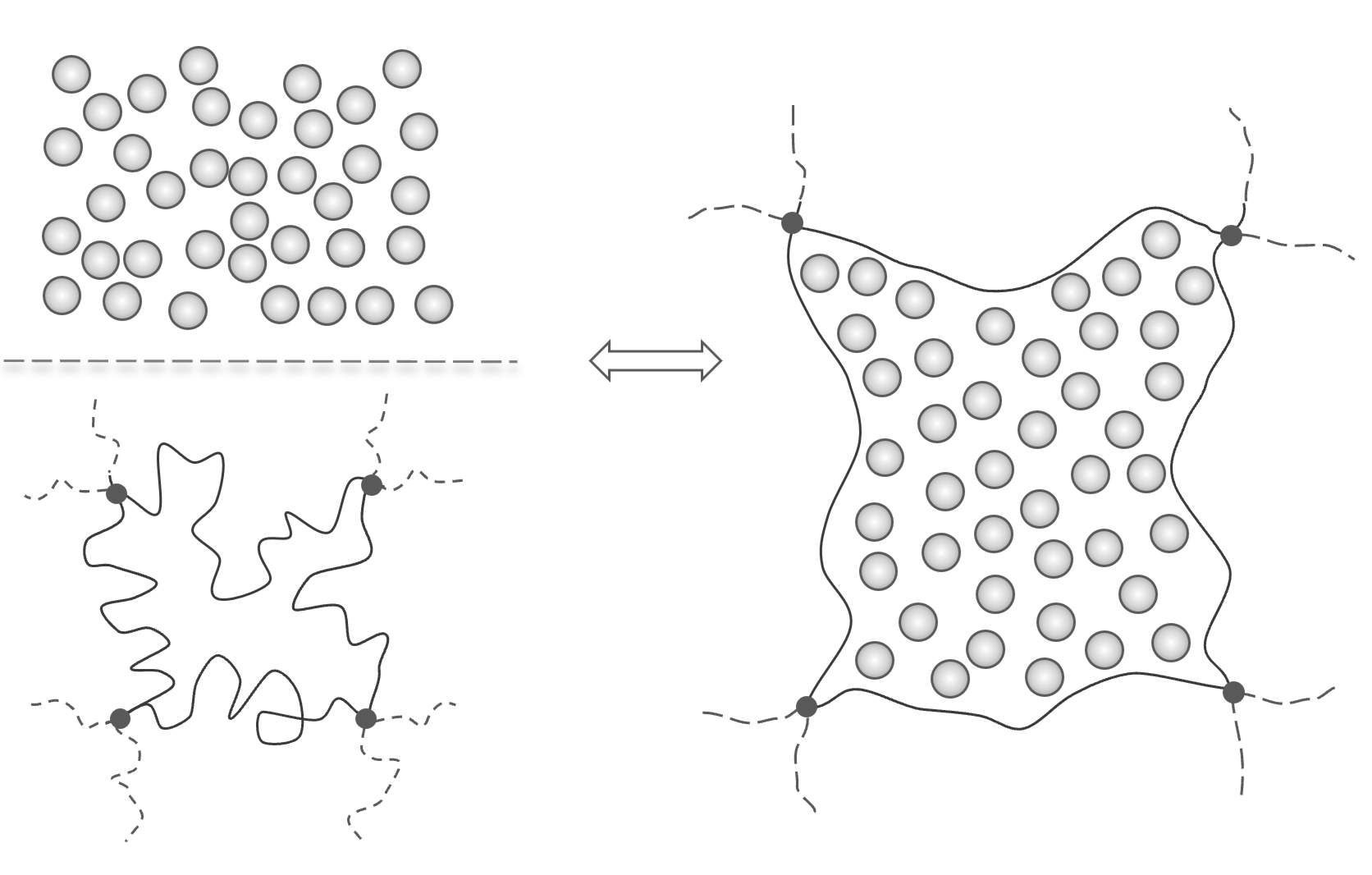Flory-Rehner Theory
of Polymer Network Swelling
The thermodynamics of swelling of network structures was first investigated by Paul Flory and J. Rehner in the early 1940s.1-3 They developed a model that describes the isotropic swelling of rubber crosslinked in the dry state. Their model was later extended by Stephen Bruck to include anisotropic networks.4
A three-dimensional network polymer such as vulcanized rubber may absorb large amounts of liquid when exposed to a compatible diluent. Under these conditions, swelling of the network will occur and an elastic retractive force develops. The driving force of the swelling process is mainly enthalpic in nature. As the volume of the network increases the chains are stretched which, in turn, causes a decrease in entropy because the extended configuration of the chains is less likely. Thus, an elastic retractive force develops. An equilibrium is eventually reached when the two opposing forces become equal.

Flory and Rehner assumed that the elastic (ΔFel) and mixing (ΔFmix) contributions to the free energy of swelling of dry polymer networks are separable and additive:
ΔF = ΔFmix - ΔFel
where ΔF is the total free energy change involved in the mixing of pure solvent with the crosslinked network, ΔFmix is the free energy of mixing, and ΔFel is the elastic free energy. The free energy change on mixing, ΔFmix, can be calculated with the Flory-Huggins lattice theory. Assuming one single network polymer molecule, the number of individual polymer molecules can be set zero, Np = 0. Then the free energy of mixing maybe written
ΔFmix / kT ≈ Ns ln φs + χps Ns φp
where Ns is the number of solvent molecules and φs and φp are the volume fractions of the solvent and polymer in the polymer network, respectively.5
By analogy with the elasticity of rubbers, the deformation process during swelling is assumed to occur without appreciable change in internal free energy of the polymer network. Then according to the statistical theory of rubber elasticity we may write
ΔFel = (VnkT / 2) · [αx2 + αy2 + αz2 - 3 - ln(αxαyαz)]
where V is the volume of the rubber cube, n is the number of network subchains per unit volume, i.e. the number of chains between crosslinks, and αi = Ri / Ri,0 are the extension ratios of the rubber strands in the three principal directions, ex, ey, ez. In the case of two-dimensional isotropy, such as in crosslinked fibers, αx ≠ αy = αz. With α = αy = αz the expression above simplifies to
ΔFel = (VnkT / 2) · [2α2 + αx2 - 3 - ln(αxα2)]
and for a fully isotropic polymer network, αx = αy = αz:
ΔFel = (VnkT / 2) · [3α2 - 3 - ln α3]
To determine the crosslink density, the weight of the swollen (V) and unswollen network (V0) at equilibrium is measured. From a knowledge of the densities of the solvent and polymer, one can calculate q = V / V0. Assuming that mixing occurs without an appreciable change in the total volume of the system (polymer plus solvent), the deformation factor for an isotropic polymer network may be written
α3 = 1 / φp = (V0 + Ns vs) / V0
It follows that
(∂α / ∂Ns)T,p = vs / 3α2V0
where vs is the volume of a solvent molecule. The swelling equilibrium is reached when the chemical potential of the solvent in the swollen network μs is equal to that of the pure solvent μs0. At this point, the polymer volume fraction has the value φp = φp,m. The chemical potential of the solvent in the swollen polymer network is given by
(μs - μs0) = (∂ΔFel / ∂α)T,p (∂α / ∂Ns)T,p + (∂ΔFmix / ∂Ns)T,p
Evaluating all three derivatives yields
(μs - μs0) / RT = ln φs + φp + χps φp2 + (vs / 3α2V0) (Vn/ 2) · [6α - 3/α]
and with (μs - μs0) / RT = 0
ln (1 - φp,m) + φp,m + χps φp,m2 = - (vs νe / V0) · [φp,m1/3 - φp,m/2]
where νe = Vn = M / Mc is the effective number of chains in the network, Mc is the (average) molecular weight between crosslinks, and M is the mass of the rubber cube.
At low degree of crosslinking, i.e. at large Mc, φp,m1/3 is considerably larger than φp,m /2. Then as a first approximation, the second term of the right-hand side may be neglected. Expanding the logarithm on the left-hand side and neglecting higher terms in the series expansion, results in an equation that can be easily solved. The result is the Flory-Rehner expression for isotroplc swelling of rubber:
νe = (V0 φp,m5/3) · (1/2 - χps ) / vs
For nonpolar systems, the interaction parameter χps can be expressed in terms of solubility parameters:
νe = (V0 φp,m5/3) · {(2 vs)-1 - (δs - δp )2 / RT}
If we know the molar volume of the solvent vs, and the Flory-Huggins interaction parameter χps (or solubility parameters of the solvent and polymer) and measure the volume of the swollen and unswollen polymer network at its equilibrium, the effective crosslink density νe may be calculated.
References & Notes
P.J. Flory and J. Rehner, J. Chem. Phys., 11, 521 (1943)
P. J. Flory, J. Chem. Phys. 18, 521 (1943)
Paul L. Flory, Principles of Polymer Chemistry, Ithaca, New york, 1953
S. D. Bruck, J. of Research of the National Bureau of Standards, A. Physics and Chemistry, Vol. 65A, No.6 (1961)
χps is the so called Flory-Huggins interaction parameter. It describes the polymer-solvent interaction:
χps = ΔHmix / (kT Ns φp)
If we assume that the cross-interaction energy is the geometric average of the interaction energies of the pure components, and that the molar volume of the solvent and polymer are identical, then the interaction parameter can be estimated with (see Hildebrand-Scott theory)
χH ≈ vs (δp - δs)2 / RT